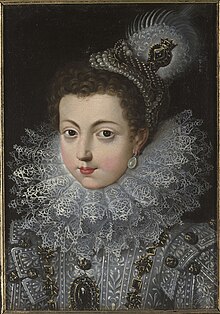Elisabeth of France, Queen of Spain
| Elisabeth of France | |
|---|---|
Royal Alcazar of Madrid, Madrid, Crown of Castile, Spain | |
| Burial | |
| Spouse |
Maria Theresa, Queen of France |
| House | Bourbon |
| Father | Henry IV of France |
| Mother | Marie de' Medici |

Elisabeth of France or Isabella of Bourbon (22 November 1602 – 6 October 1644) was
Life
Childhood

Elisabeth was born at Château de Fontainebleau on 22 November 1602, the eldest daughter of King Henry IV of France and his second wife, Marie de' Medici. According to the court, her mother showed a cruel indifference to her, because she had believed the prophecy of a nun who assured her that she would give birth to three consecutive sons.[2]
Shortly after her birth, she was betrothed to Philip Emmanuel, Prince of Piedmont, son and heir of Charles Emmanuel I, Duke of Savoy, by Catherine Michaela, daughter of King Philip II of Spain. However, Philip Emmanuel died of smallpox in 1605.[3][4]
As a daughter of the King of France, she was born a
In 1612, when Elisabeth was ten years old, negotiations were begun for a double marriage between the royal families of France and Spain; Elisabeth would marry the Prince of Asturias (the future Philip IV of Spain) and her brother Louis, the Spanish Infanta Anne.
Marriage
This marriage followed a tradition of cementing military and political alliances between the Catholic powers of France and Spain with royal marriages. The tradition went back to 1559 with the marriage of King
Queen

Elisabeth was renowned for her beauty, intelligence and noble personality, which made her very popular in Spain.
In 1621, the couple had ascended to the throne of Spain upon the death of Philip III of Spain. The new queen of Spain was aware that her husband had mistresses.
Elisabeth herself was the subject of rumors about her relations with the noted poet Peralta (Juan de Tassis, 2nd Count of Villamediana), who was her gentleman-in-waiting. On 14 May 1622, a fire broke out while the Peralta masque La Gloria de Niquea was being acted before the court. Peralta carried the queen to a place of safety, which caused suspicion about their relationship to deepen. Peralta neglected a significant warning that his life was in peril, and "he was murdered as he stepped out of his coach. The responsibility for his death was divided between Philip IV and Olivares" (at the time, prime minister and king's favorite).
She was regent of Spain during the Catalan Revolt and supported the Duke of Nochera against the Count-Duke of Olivares in favor of an honorable withdrawal from the Catalan Revolt.
Prior to 1640, the queen does not appear to have had much influence over state affairs, which was largely entrusted to Olivares. Elisabeth did not get along with Olivares, who reportedly assisted Philip IV in his adultery, and prevented her from achieving any political influence and once famously remarked, when she presented a political view to the king, that priests existed to pray as well as queens existed to give birth.[1]
Between 1640 and 1642, Elisabeth served as regent for the king in his absence during the Catalan revolt and was given very good marks for her efforts.[1] She was reputed to have influenced the fall of Olivares as a part of a "women's conspiracy" alongside the duchess of Mantua, Ana de Guevara, María de Ágreda and her chief lady-in-waiting Luisa Manrique de Lara, Countess Paredes de Nava.[1]
The fall of Olivares made the king consider her his only political partner, and when the king left again for the front in 1643, Elisabeth was again appointed regent assisted by Juan Chumacero Carrillo y Sotomayor.[1] Her second regency was also well received, and she was credited by the king for her efforts to provide vital supplies for the troops as well as for her negotiations with the banks to provide finances for the army, offering her own jewelry as security.[1] It was rumored that she was intending to follow the example of Queen Isabella the Catholic and lead her own army to retake Badajoz.[1]
The Queen died in Madrid on 6 October 1644 at the age of forty-one, leaving two children:
Issue
- Maria Margaret of Austria, Infanta of Spain (14 August 1621 – 15 August 1621), died in infancy
- Margaret Maria Catherine of Austria, Infanta of Spain (25 November 1623 – 22 December 1623), died in infancy
- Maria Eugenia of Austria, Infanta of Spain (21 November 1625 – 21 August 1627), died in infancy
- Isabella Maria Theresa of Austria, Infanta of Spain (31 October 1627 – 1 November 1627), died in infancy
- Balthasar Charles of Austria, Infante of Spain, Prince of Asturias (17 October 1629 – 9 October 1646), Prince of Asturias.
- Maria Anna Antonia Dominica Jacinta of Austria, Infanta of Spain (17 January 1636 – 5 December 1636), died in infancy
- Louis XIV of Franceand had issue.
Elisabeth also suffered at least three miscarriages:
- A miscarried daughter (16 November 1626)
- A miscarried daughter (1640)
- A miscarried son (1644)
Gallery
-
Elisabeth portrayed by Rodrigo de Villandrando
-
Elisabeth portrayed by Velázquez
-
Elisabeth portrayed by Velázquez, 1632
-
An equestrian portrait of Elisabeth by Velázquez, 1632
Ancestors
| Ancestors of Elisabeth of France Anna of Bohemia and Hungary | |||||||||||||
|---|---|---|---|---|---|---|---|---|---|---|---|---|---|
External links
- Diccionario Biográfico. Real Academia de la Historia Isabel de Borbón
References
- ^ a b c d e f g Diccionario Biográfico. Real Academia de la Historia Isabel de Borbón
- ^ a b La reina desdichada, Isabel de Borbón (1602-1644) in: mujeresenlahistoria.com (in Spanish) [retrieved 11 April 2014].
- ^ Isabel de Borbón in: mcnbiografias.com (in Spanish) [retrieved 11 April 2014].
- ^ Isabel de Borbón, reina de España, primera esposa de Felipe IV in: museodelprado.es (in Spanish) [retrieved 11 April 2014].
- ^ Robert Knecht, Renaissance France, genealogies; Baumgartner, genealogical tables.




